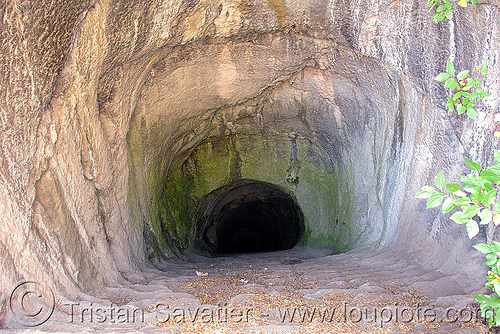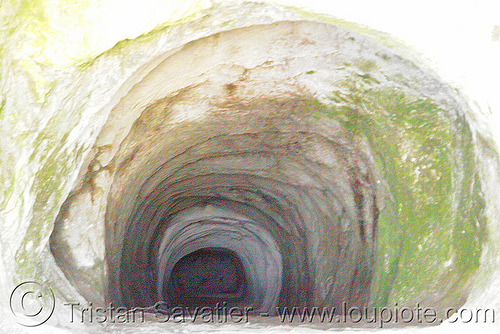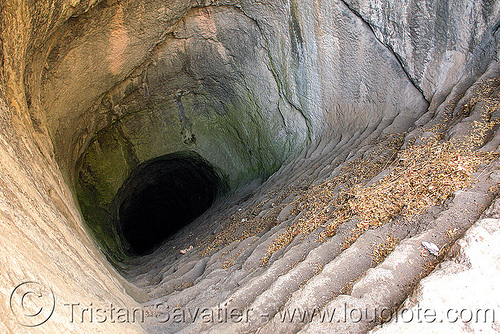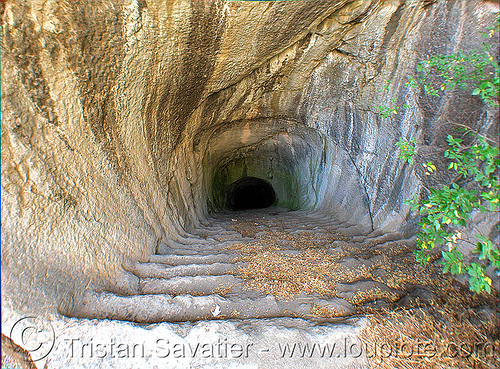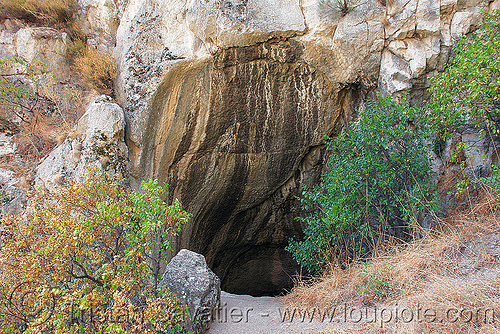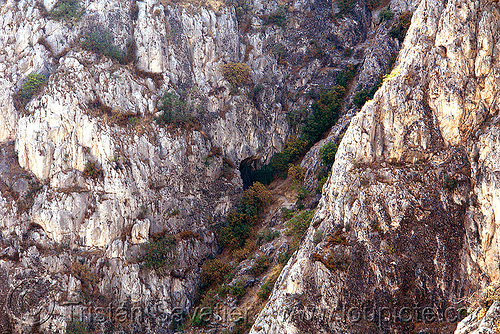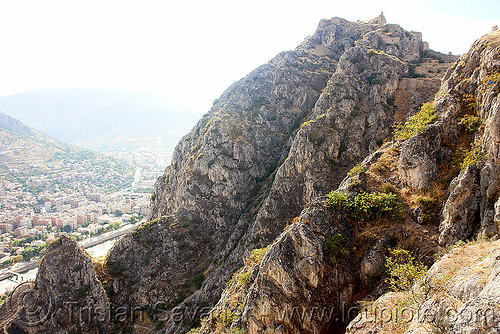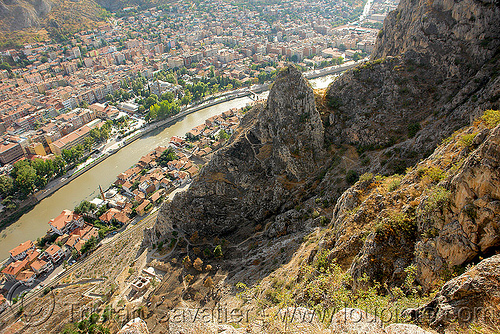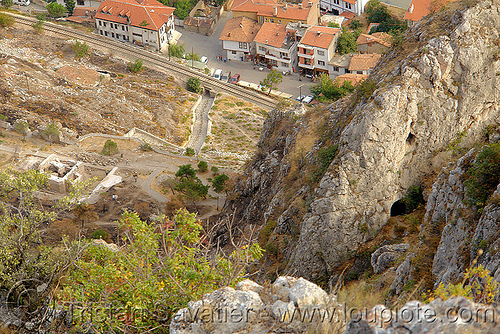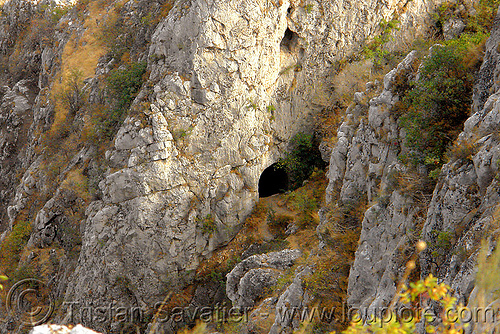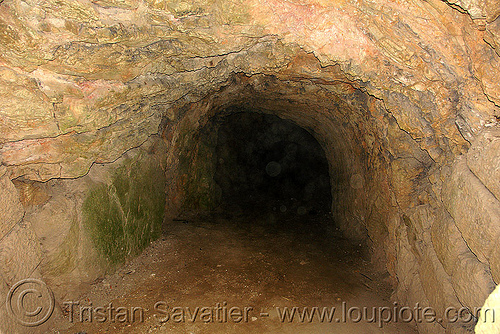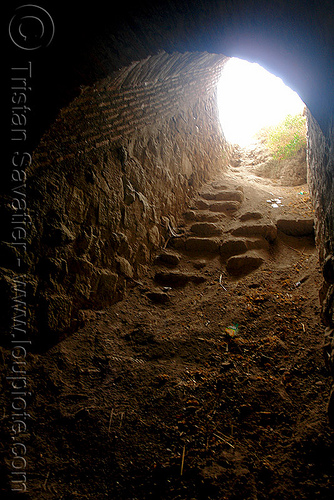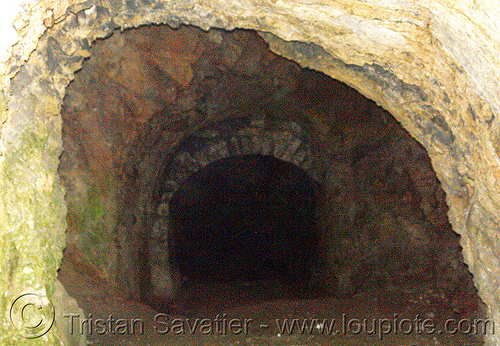the cilanbolu tunnels (amasya, turkey) - 13 photos
If you have contact information for the archaeologists involved with the Cilanbolu excavations in Amasya, please email me, thanks!
While hiking a very steep and narrow gorge leading to the castle high above the town of Amasya (Turkey), I stumbled upon a very intriguing man-made tunnel going straight into the mountain with a very steep down angle. This is one of the "Cilanbolu Tunnels", and I was later told that there are 4 of them in the mountain above Amasya. I later located 2 more Cilanbolu (I didn't find the fourth one).
From the information that I gathered (e.g. by discussing with the Amasya archeology museum director), and from my direct observation of two of the Cilanbolu, here some information about those amazing tunnels.
3 of the 4 Cilanbolu tunnels are very old, possibly dating from the Pontic Empire (300 BC). Those are very steep tunnels (angle about 60 degrees down from horizontal), going straight into the mountain, and apparently they "go nowhere", i.e. they stop at one point. The upper part of those Cilanbolu have stairs / steps carved in the rock but they are so steep that it is too dangerous to enter them without a safety rope.
The first tunnel that I discovered is one of those. The entrance is about 5 meters in diameter, and it has steps going down for about 15-20 meters. Then the diameter of the tunnel suddenly becomes smaller (about 2 meters), and there are no more steps. The tunnel continues straight for about 160m, and stops. Given the location of the tunnel (in a narrow steep gorge under the castle), I suspect that those type of Cilanbolu tunnels were actually water cistern, i.e. they would capture rain water from this narrow gorge and funnel it into this tunnel, where it would be trapped in the deep tunnel and hopefully stay there for some time if the rock is not too porous. With no sun light and little air contact, the water kept underground could stay drinkable for a very long time, providing a large water supply to the castle located a couple of hundred meters above, at the top of the hill. See my photos of this tunnel.
There is another theory that the Cilanbolu could be Mithraic cult shrines, but I do not believe that this is the case, based on my observation. The Cilanbolu that I found in the steep gorge is most likely a water cistern.
One of the Cilanbolu tunnels looks different and seems to be relatively more recent, dating from the Roman or medieval period. This tunnel is located under one of the ruined tower of the castle, and at the time, some climbing and scrambling up the ruins was needed to access it. This tunnel is not as steep as the others (only about 30-degree) and originally had stone stairs (now covered with earth and debris). It looks very much like a classic medieval underground tunnel, with masonry vaults reinforcements and the entrance has a brick vault. I explored 50-80 meter of it. It goes straight, and i'm not sure if it was originally a castle escape route or an access to an underground water well or cistern. But unlike the other Cilanbolu tunnels, the tunnel itself does not appear to be a water well or cistern, but rather a passageway for people. See my photos of this tunnel.
Until 2006, there is been no archeological study or exploration of the Cilanbolu tunnels, which were considered "too dangerous to go in". According to an Urban Legend, an archeologist went down in one of the tunnels in the 1900's, and he never came out.
In 2008, Archeogical excavations of the castle Cilanbolu took place during the Restoration of the Amasya castle (which was just a pile of rubble when I saw it, but has now been partly "reconstructed" for tourism purpose). They excavated 170m of this straight tunnel until they reached a point where the tunnel was filled with water. It is unknown if the tunnel leads to a water cistern or is just obstructed. The plan is to eventually open this tunnel to the public as part of the castle visit. See article (in Turkish) here:
www.kenthaber.com/karadeniz/amasya/Haber/Genel/Normal/giz...
www.suluovagazetesi.com/haber_oku.asp?haber=2056
www.suluovagazetesi.com/haber_oku.asp?haber=2358
nethaber.com/Toplum/65417/GIDENIN-GERI-DONMEDIGI-MAGARA-I...
www.harbiforum.org/amasya/97532-amasya-gumushacikoy.html
In 2009, Archeogical excavations of the Cilanbolu cistern that I discovered in the remote gorge took place. Here is an article about it:
arkeolojihaber.net/2009/04/23/tarihi-magara-karanliktan-k... (in Turkish)
www.kenthaber.com/karadeniz/amasya/Haber/Genel/Normal/tar...
Also you can read another article and a photo of the Cilanbolu cistern taken just one month after i took my photos, and posted by Rob on Flickr: www.flickr.com/photos/97924400@N00/2907914043/
Other news:
On april 11, 2011, a 16-year old boy died when he fell in one of the cilanbolu tunnels, 195m deep and filled with water. Read the article (in Turkish): www.ikincikat.com/haberler.asp?haber=goster&haberne=7...
